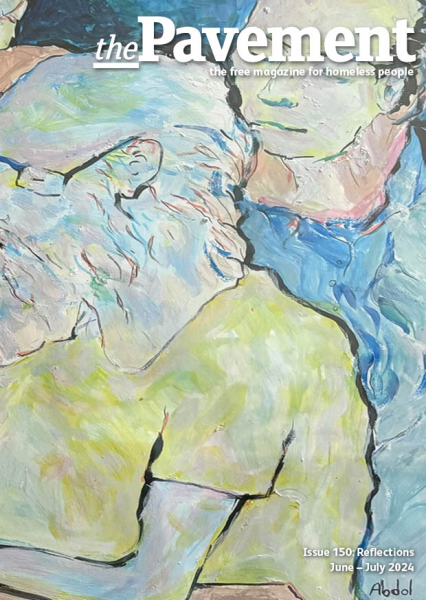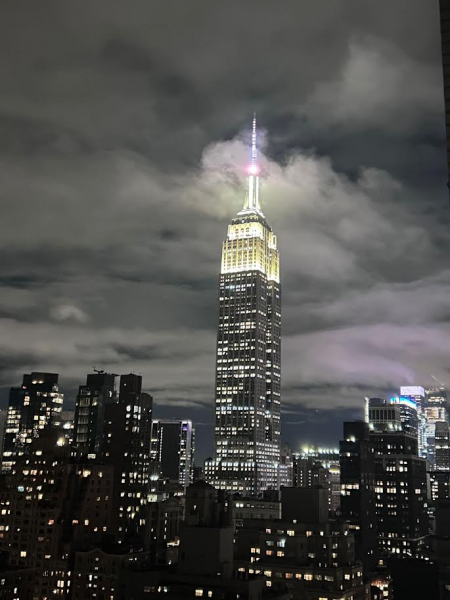
Established 2005 Registered Charity No. 1110656
Scottish Charity Register No. SC043760
DONATE
RECENT TWEETS
The similarities and differences in homeless policy in New York and London. With a view to what comes next. By Eric Protein Moseley
In the late 1990s, I remember relocating to New York for the first time as a single-parent homeless drug addict, trying to provide a better life for my daughter Erica than I'd had so far. Together, we got off the greyhound bus at Port Authority and soon entered the city shelter system in the Bronx, New York. After residing at several locations for approximately eight months, we eventually got an apartment in Brooklyn, East New York. Today, the wait for a homeless family to receive housing in the Big Apple has become much longer and more humiliating.
The latest Mayors’ Management Report shows that families with children spent an average of 534 days, or almost 18 months, in the Department of Homeless Services (DHS) care during the 2022 financial year, completed in June. Following decades of failed policy strategies the number of men, women and children living in homeless shelters stands at around 60,000.
Today, New Yorkers in the shelter system face countless hardships in getting into permanent housing because rents are at record highs, and the accessibility of units estimated for low-income rent occupants is at a decades-old low. The city saves just a few of its affordable units explicitly for low-income renters, contributing to the rise of homelessness in New York City.
Before the Covid-19 pandemic, New York's plans to combat homelessness were:
1. Providing low-cost housing in conjunction with supportive services to create permanent supportive housing, such as medical care and counselling.
2. Making one-time funds available, such as government funds for rapid rehousing.
3. Creating Non-congregate housing, which entails placing homeless people in hotels.
Across the pond in London, The Combined Homeless and Information Network (CHAIN) shows a rise in rough sleeping across London, with 2,998 people sleeping rough from April to June 2022, up 16% on the same period in 2021.
Projects supported and initiated by London’s mayor, Sadiq Khan, to reduce homelessness in the city have included:
1. A recently renovated No Second Night Out service, offering people sleeping rough assistance in a safe environment.
2. Creating expert multidisciplinary psychological wellness groups in NHS Trusts, with a focus on homeless people.
3. Establishing a dedicated administration that responds quickly to StreetLink references to ensure people receive assistance as soon as possible.
The invasion of Russia in Ukraine will also contribute to the growing number of homelessness in both London and New York. An estimated 50,000 Ukrainian refugees in the UK could become homeless this year, and ministers are resisting offering a new package of support to offset the impending crisis.
While the shelter system in New York is struggling to house arrivals from Ukraine, New York City mayor Eric Adams is considering erecting hangar-sized tents as temporary shelters for thousands of migrants experiencing homelessness.
In my opinion, both London and New York already had a problem finding solutions to rising homelessness before the displacement of people because of the Russian invasion of Ukraine. With the war ending in Ukraine nowhere in sight, I suggest both locations should expect and plan for more people to come to their cities, not as tourists but as people looking to find a permanent place to live, like many others who were already homeless before they arrived.
- Eric Moseley is a New York-based social impact documentary film-maker
June – July 2024 : Reflections
CONTENTS
BACK ISSUES
- Issue 150 : June – July 2024 : Reflections
- Issue 149 : April – May 2024 : Compassion
- Issue 148 : February – March 2024 : The little things
- Issue 147 : December 2023 – January 2024 : Next steps
- Issue 146 : October 2023 – November 2023 : Kind acts
- Issue 145 : August 2023 – September 2023 : Mental health
- Issue 144 : June 2023 – July 2023 : Community
- Issue 143 : April 2023 - May 2023 : Hope springs
- Issue 142 : February 2023 - March 2023 : New Beginnings
- Issue 141 : December 2022 - January 2023 : Winter Homeless
- Issue 140 : October - November 2022 : Resolve
- Issue 139 : August - September 2022 : Creativity
- Issue 138 : June - July 2022 : Practical advice
- Issue 137 : April - May 2022 : Connection
- Issue 136 : February - March 2022 : RESPECT
- Issue 135 : Dec 2021 - Jan 2022 : OPPORTUNITY
- Issue 134 : September-October 2021 : Losses and gains
- Issue 133 : July-August 2021 : Know Your Rights
- Issue 132 : May-June 2021 : Access to Healthcare
- Issue 131 : Mar-Apr 2021 : SOLUTIONS
- Issue 130 : Jan-Feb 2021 : CHANGE
- Issue 129 : Nov-Dec 2020 : UNBELIEVABLE
- Issue 128 : Sep-Oct 2020 : COPING
- Issue 127 : Jul-Aug 2020 : HOPE
- Issue 126 : Health & Wellbeing in a Crisis
- Issue 125 : Mar-Apr 2020 : MOVING ON
- Issue 124 : Jan-Feb 2020 : STREET FOOD
- Issue 123 : Nov-Dec 2019 : HOSTELS
- Issue 122 : Sep 2019 : DEATH ON THE STREETS
- Issue 121 : July-Aug 2019 : INVISIBLE YOUTH
- Issue 120 : May-June 2019 : RECOVERY
- Issue 119 : Mar-Apr 2019 : WELLBEING
- Issue 118 : Jan-Feb 2019 : WORKING HOMELESS
- Issue 117 : Nov-Dec 2018 : HER STORY
- Issue 116 : Sept-Oct 2018 : TOILET TALK
- Issue 115 : July-Aug 2018 : HIDDEN HOMELESS
- Issue 114 : May-Jun 2018 : REBUILD YOUR LIFE
- Issue 113 : Mar–Apr 2018 : REMEMBRANCE
- Issue 112 : Jan-Feb 2018
- Issue 111 : Nov-Dec 2017
- Issue 110 : Sept-Oct 2017
- Issue 109 : July-Aug 2017
- Issue 108 : Apr-May 2017
- Issue 107 : Feb-Mar 2017
- Issue 106 : Dec 2016 - Jan 2017
- Issue 105 : Oct-Nov 2016
- Issue 104 : Aug-Sept 2016
- Issue 103 : May-June 2016
- Issue 102 : Mar-Apr 2016
- Issue 101 : Jan-Feb 2016
- Issue 100 : Nov-Dec 2015
- Issue 99 : Sept-Oct 2015
- Issue 98 : July-Aug 2015
- Issue 97 : May-Jun 2015
- Issue 96 : April 2015 [Mini Issue]
- Issue 95 : March 2015
- Issue 94 : February 2015
- Issue 93 : December 2014
- Issue 92 : November 2014
- Issue 91 : October 2014
- Issue 90 : September 2014
- Issue 89 : July 2014
- Issue 88 : June 2014
- Issue 87 : May 2014
- Issue 86 : April 2014
- Issue 85 : March 2014
- Issue 84 : February 2014
- Issue 83 : December 2013
- Issue 82 : November 2013
- Issue 81 : October 2013
- Issue 80 : September 2013
- Issue 79 : June 2013
- Issue 78 : 78
- Issue 77 : 77
- Issue 76 : 76
- Issue 75 : 75
- Issue 74 : 74
- Issue 73 : 73
- Issue 72 : 72
- Issue 71 : 71
- Issue 70 : 70
- Issue 69 : 69
- Issue 68 : 68
- Issue 67 : 67
- Issue 66 : 66
- Issue 65 : 65
- Issue 64 : 64
- Issue 63 : 63
- Issue 62 : 62
- Issue 61 : 61
- Issue 60 : 60
- Issue 59 : 59
- Issue 58 : 58
- Issue 57 : 57
- Issue 56 : 56
- Issue 56 : 56
- Issue 55 : 55
- Issue 54 : 54
- Issue 53 : 53
- Issue 52 : 52
- Issue 51 : 51
- Issue 50 : 50
- Issue 49 : 49
- Issue 48 : 48
- Issue 47 : 47
- Issue 46 : 46
- Issue 45 : 45
- Issue 44 : 44
- Issue 43 : 43
- Issue 42 : 42
- Issue 5 : 05
- Issue 4 : 04
- Issue 2 : 02
- Issue 1 : 01
- Issue 41 : 41
- Issue 40 : 40
- Issue 39 : 39
- Issue 38 : 38
- Issue 37 : 37
- Issue 36 : 36
- Issue 35 : 35
- Issue 34 : 34
- Issue 33 : 33
- Issue 10 : 10
- Issue 9 : 09
- Issue 6 : 06
- Issue 3 : 03
- Issue 32 : 32
- Issue 31 : 31
- Issue 30 : 30
- Issue 29 : 29
- Issue 11 : 11
- Issue 12 : 12
- Issue 13 : 13
- Issue 14 : 14
- Issue 15 : 15
- Issue 16 : 16
- Issue 17 : 17
- Issue 18 : 18
- Issue 19 : 19
- Issue 20 : 20
- Issue 21 : 21
- Issue 22 : 22
- Issue 23 : 23
- Issue 24 : 24
- Issue 25 : 25
- Issue 8 : 08
- Issue 7 : 07
- Issue 26 : 26
- Issue 27 : 27
- Issue 28 : 28
- Issue 1 : 01

